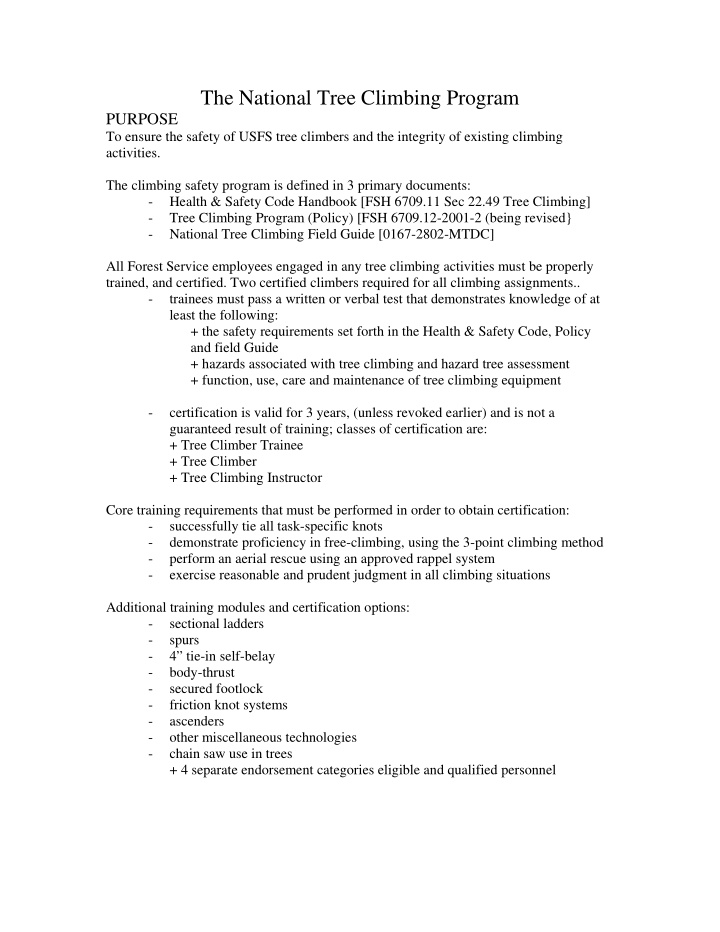



The National Tree Climbing Program PURPOSE To ensure the safety of USFS tree climbers and the integrity of existing climbing activities. The climbing safety program is defined in 3 primary documents: - Health & Safety Code Handbook [FSH 6709.11 Sec 22.49 Tree Climbing] - Tree Climbing Program (Policy) [FSH 6709.12-2001-2 (being revised} - National Tree Climbing Field Guide [0167-2802-MTDC] All Forest Service employees engaged in any tree climbing activities must be properly trained, and certified. Two certified climbers required for all climbing assignments.. - trainees must pass a written or verbal test that demonstrates knowledge of at least the following: + the safety requirements set forth in the Health & Safety Code, Policy and field Guide + hazards associated with tree climbing and hazard tree assessment + function, use, care and maintenance of tree climbing equipment - certification is valid for 3 years, (unless revoked earlier) and is not a guaranteed result of training; classes of certification are: + Tree Climber Trainee + Tree Climber + Tree Climbing Instructor Core training requirements that must be performed in order to obtain certification: - successfully tie all task-specific knots - demonstrate proficiency in free-climbing, using the 3-point climbing method - perform an aerial rescue using an approved rappel system - exercise reasonable and prudent judgment in all climbing situations Additional training modules and certification options: - sectional ladders - spurs - 4” tie-in self-belay - body-thrust - secured footlock - friction knot systems - ascenders - other miscellaneous technologies - chain saw use in trees + 4 separate endorsement categories eligible and qualified personnel
OBJECTIVE Accomplish climbing tasks to help meet Agency mandates in multiple program areas: Reforestation and restoration - cone surveys and collection - tree punning and maintenance Genetics - tree breeding and controlled pollination - pollen and scion collection - cone caging - TI cone collection TE & S - red tree vole surveys - marbled murretet surveys - spotted owl survey and manage - red-cockaded woodpecker management and artificial nest installation Insects & Disease - specimen collection - asian longhorned beetle survey - trapping - mistletoe broom removal Research - bald eagle and other raptors - Puerto Rico parrot - monitoring equipment installation - foliar sampling - neotropical bird nest surveys - DNA sampling Wildlife - fungal inoculum installation and tree topping - osprey nest platform construction - installation of bear-proof food supports Other - phone line maintenance - solar panel and antenna installation - hazard limb and tree removal - remote runway tree pruning - abandoned equipment removal (from “tree sitters”)
PROGRAM MANAGEMENT Program and Deputy Program managers, Region, Station & Area coordinators and Technical Advisors (comprise the Technical Advisory Group [TAG]) - reviews and recommends changes to program to provide safest work practices - manage operations - ensure operational effectiveness - provide operational and technical advise to climbers - recommend changes to Policy and/or technical guidelines in Field Guide - approve use of new equipment, techniques and practices Program outreach - setting example for other Agencies & groups - rely on the FS expertise for training, advise and assistance
Recommend
More recommend